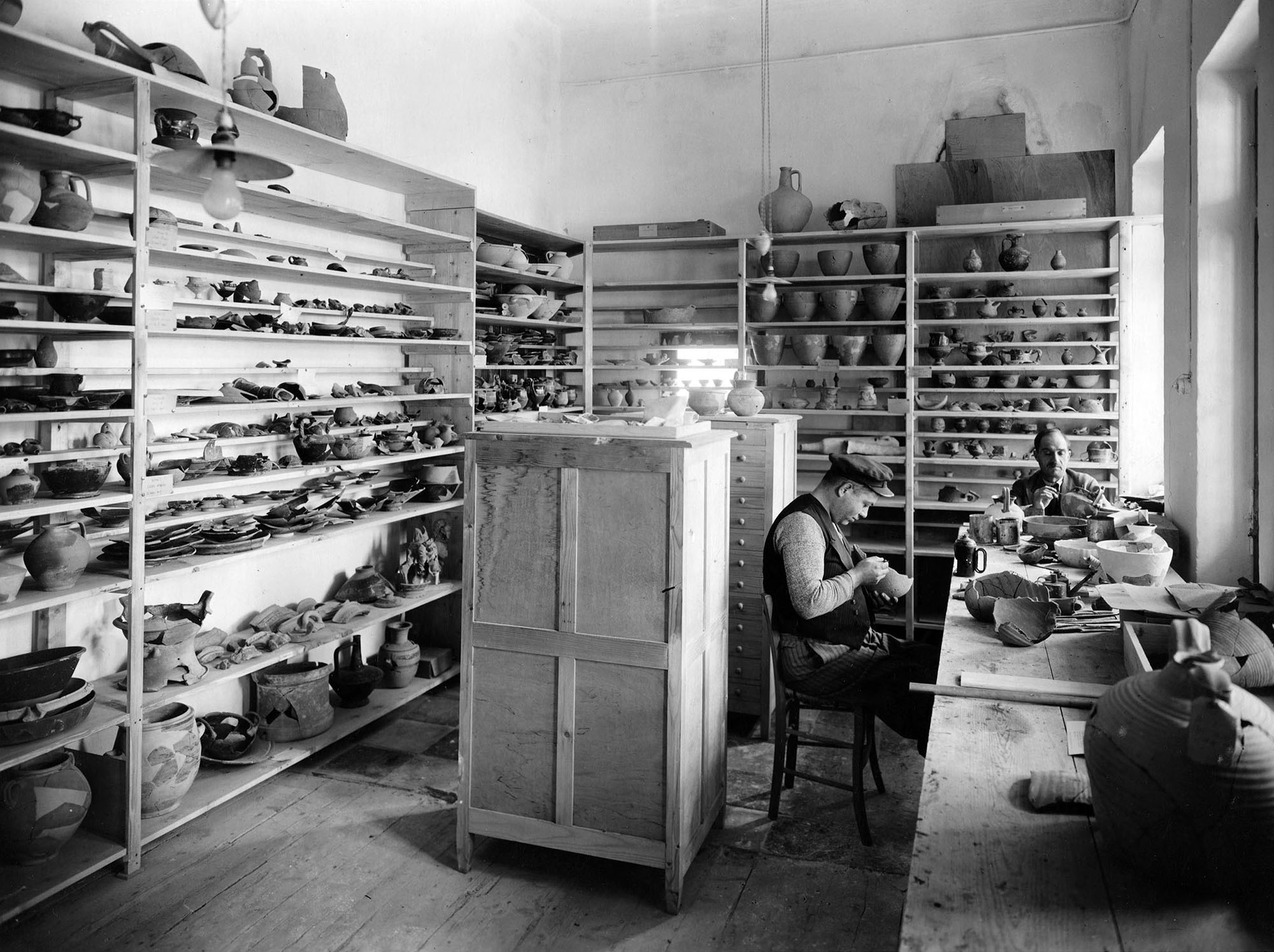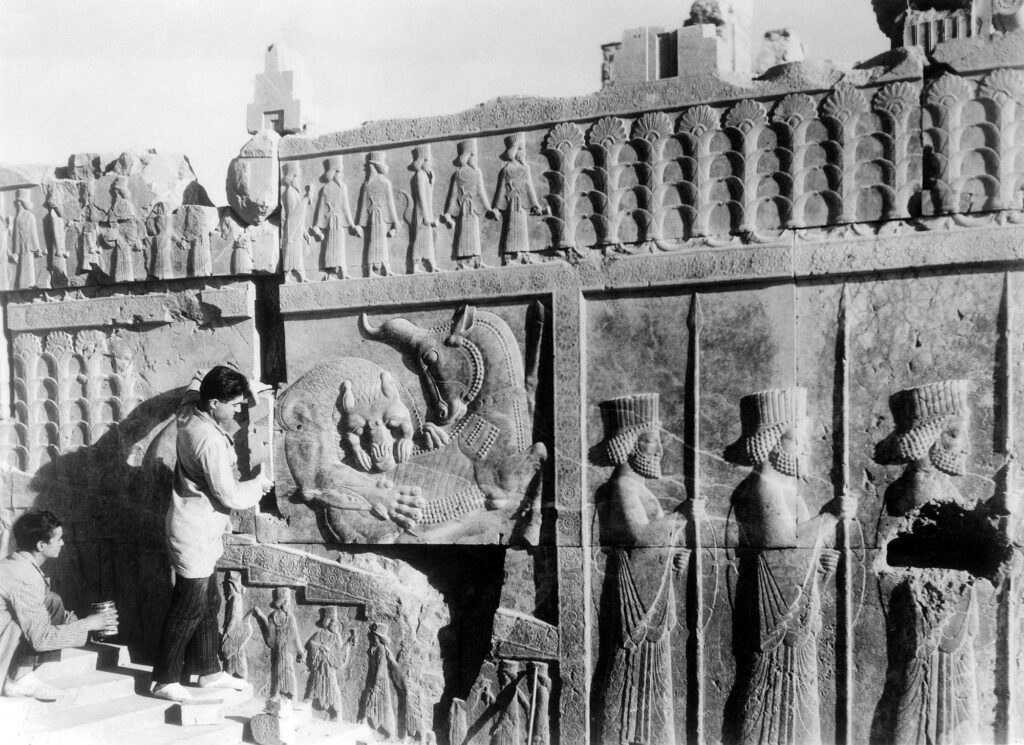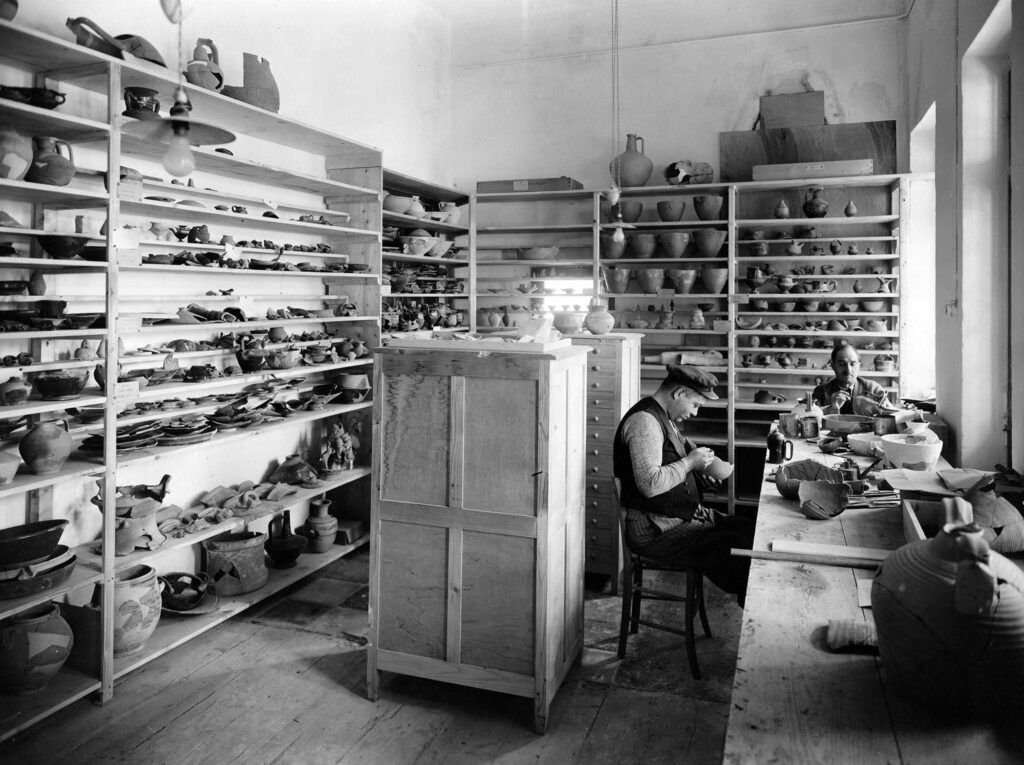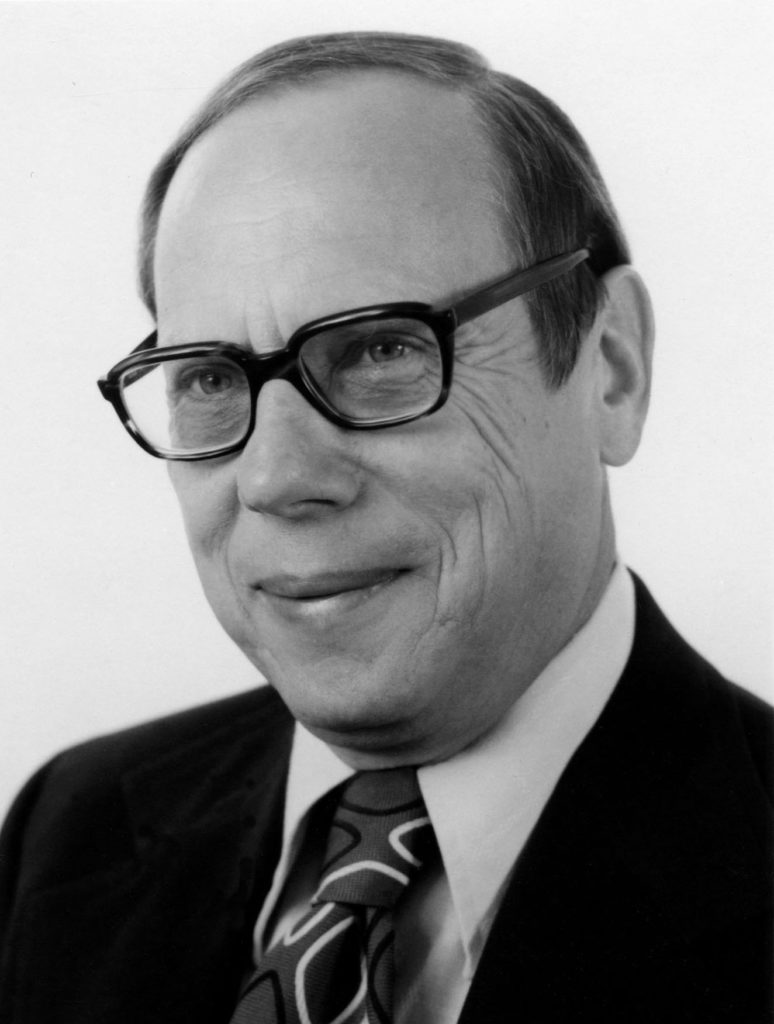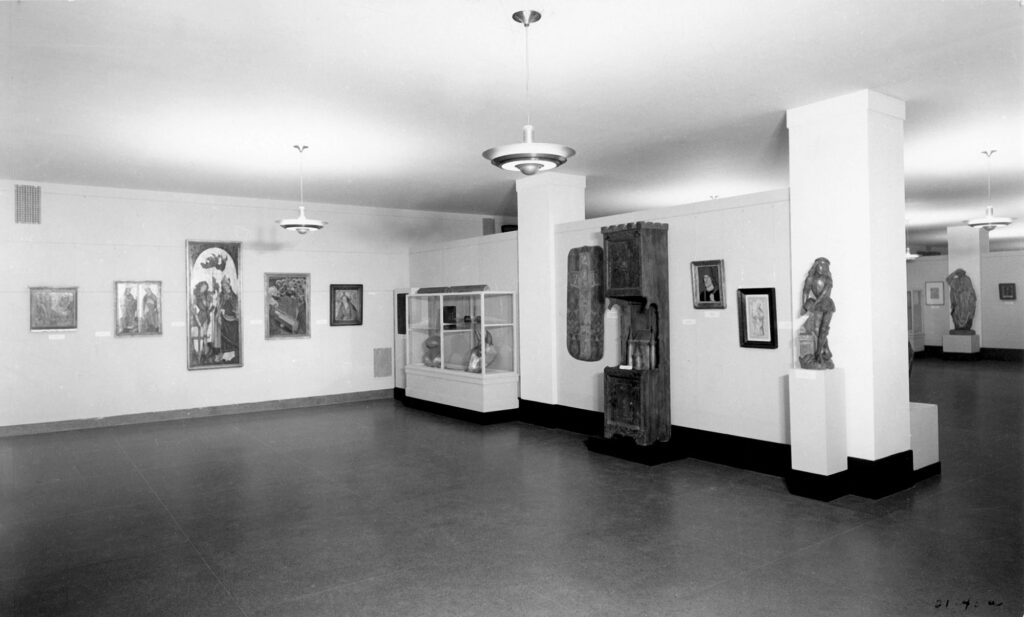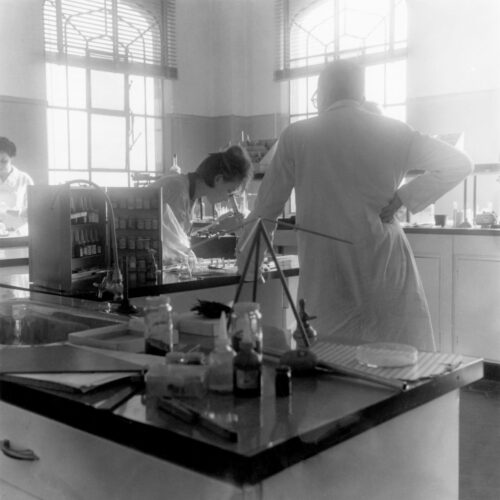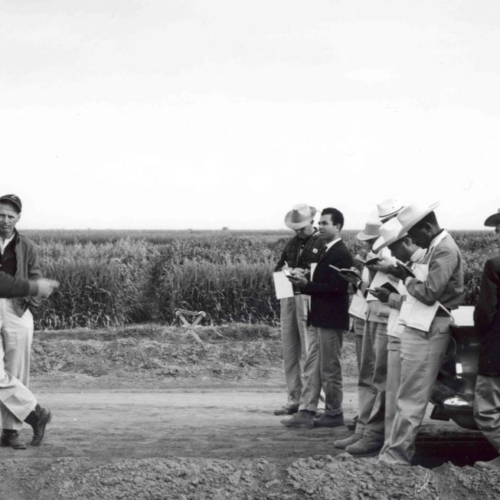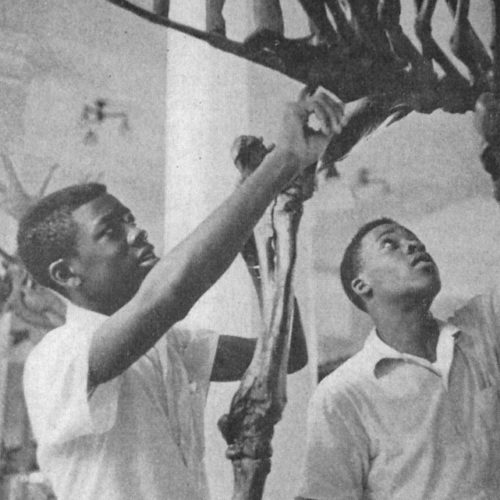The Rockefeller Foundation’s (RF) work in the humanities began when the Foundation was reorganized in 1928. It inherited work initiated by the General Education Board (GEB), most of it in the fields of classics, archaeology, and art history. Several large, multi-year grants to five elite universities had also aimed to stimulate interest in the humanities. Only gradually was the Foundation able to refocus its work, moving from western Europe and the Middle East to explore diverse American cultures and other, less familiar parts of the world, especially Slavic and Asian cultures. As the Great Depression unfolded, RF also aimed to broaden the definition of culture and to expand a domestic audience for the arts and humanities.
Early Work in the Humanities
The GEB’s largest appropriations in the humanities had included $780,000 over a seven-year period to the Oriental Institute at the University of Chicago and $500,000 to the Fogg Art Museum at Harvard University to build its endowment. Because the GEB could not make grants abroad, the International Education Board (IEB) provided money for programs at the American Academy in Rome ($1 million) and the American School of Classical Studies in Athens ($500,000) to support various archaeological projects and training. Edward Capps, a Princeton professor of classics, headed the new RF program in 1929-30 and continued to fund work in archaeology.
Rockefeller Foundation interest in classical archaeology was a legacy of the GEB and IEB programs and one of the abiding personal interests of John D. Rockefeller, Jr. (JDR Jr.). He was captivated by the work of the Egyptologist James H. Breasted, whose Oriental Institute received some $11 million from various Rockefeller coffers. He also personally funded excavations at the Athenian Agora when the Greek government lacked the financial resources to carry out its long-planned work on the site. In 1929 the RF appropriated funds to complete the Agora project. Rockefeller Foundation appropriations also supported fellowships to train archaeologists and to construct the Museum of the Ancient Agora to house the artifacts unearthed during excavations.
A New Understanding of the Humanities
An emphasis on classical studies reflected a traditional view of the humanities, one that did not captivate the imagination of some trustees. Although the work on archaeological sites was certainly producing new insights into the ancient world, the support for studies of Latin paleography and philological projects did not excite all Foundation members. In 1927, just prior to the RF reorganization and the creation of its Humanities Division, GEB Trustee Anson Phelps Stokes wrote to Abraham Flexner, saying,
[t]he emphasis … seems to be mainly on Ancient History, Ancient languages, and Archeology. These are very important but the word ‘Humanities’ should be understood to include a very broad field, including Art, Music, Education, Literature, Sociology, etc.
Anson Philps Stokes to Abraham Flexner, 1927Letter from Anson Phelps Stokes to Abraham Flexner, April 9, 1927, Rockefeller Archive Center, General Education Board, RG 1.2, Series 717, Box 314, Folder 3278.
David Stevens became the first full-time director of the humanities program in 1932 and approached his tasks with a new perspective. In 1937 he reviewed the early program in the humanities that had been set in motion by Flexner and the GEB. He mused: “How was this program a credit to us? In having a sense of magnitude. In what way a discredit? By buttressing scholasticism and antiquarianism in our universities.”“The Humanities in Theory and Policy” by David H. Stevens, March 31, 1937, RAC, RG 3, Series 911, Box 2, Folder 10. Many decades later, he recalled, “When I began my work as the director for humanities, my viewpoint was that the long-range fundamentals of the humanities start with people – developing young, brilliant ones – and in starting programs that are not traditional, but needed.”A Time of Humanities: An Oral History, as narrated to Robert E. Gard by David H. Stevens, edited by Robert E. Yahnke (Madison: Wisconsin House Publishers, 1976), p. 29.
Stevens strengthened the relationship with the American Council of Learned Societies (ACLS), one of RF’s most important allies. GEB had also supported ACLS, established in 1919 as a federation of professional societies in the humanities. Stevens devoted some ten percent of his budget simply to keep ACLS’s office running, describing it as “a kept society of the Rockefeller Foundation from 1920 to 1950.”A Time of Humanities: An Oral History, as narrated to Robert E. Gard by David H. Stevens, edited by Robert E. Yahnke (Madison: Wisconsin House Publishers, 1976), p. 29.More substantial grants over the years helped ACLS administer fellowships, run a grants program, and support wide-ranging humanistic research.
Stevens also sought out and nurtured projects in new fields, such as drama and communications. For the first time in its history, the RF initiated projects to broaden the role of the humanities and build audiences outside the academy. The Foundation turned its attention to regional theaters, educational and non-commercial uses of radio and documentary film, and support of microphotography to increase worldwide accessibility to library collections.
Through the decades, the Foundation continued to support major professional associations in the humanities. In the 1970s and 1980s, under the leadership of Joel Colton, the Humanities Division created a major program of fellowships for outstanding individual scholars and writers. From the mid-1980s to the mid-1990s, the Humanities Fellowship Program was administered through a variety of academic centers and programs. That strategy encouraged scholars to work together, to move their new specialties across conventional disciplinary boundaries and to help embed them in institutional life. The Foundation also supported the work of scholars concerned with reaching policy makers and citizens with fresh findings, thus encouraging the “public intellectuals” of our time. As it evolved from its early concerns with classical archaeology and art, the Foundation’s programs began to manifest a basic idea — that societal action and change should be grounded in humanistic understandings.
Advancing Museums
While far more limited in scope than its work with libraries, the Foundation also supported work in improving museums. RF grants first began in 1935, when a Trustee report identified museums as “peculiarly influential” among a public that looked to them for “cultural satisfaction.”“The Rockefeller Boards and Museums: A Resume of RF and GEB Programs” by John Marshall, December 9, 1955, Rockefeller Archive Center, RG 3, Series 911, Box 5, Folder 44. The first grant was a sum of $44,000 to the Brooklyn Museum to train promising interns from across the country in topics of museum administration and techniques of display. The interns that participated were expected to go back to their positions or to new museums in order to communicate their knowledge and take on leadership roles in the field. Further grants continued to focus on projects that aimed to improve visitor experience or focus on the public responsibility of museums, including educational outreach.
While grants continued throughout the 1930s, Foundation interest remained limited and the appropriations remained small and virtually ceased to exist during the war years. A 1955 summary of RF work in the field calculated that grants between 1934 and 1950 totaled only $302,500.“The Rockefeller Boards and Museums: A Resume of RF and GEB Programs” by John Marshall, December 9, 1955, Rockefeller Archive Center, RG 3, Series 911, Box 5, Folder 44. In the 1970s, however, the Foundation established a program of fellowships to train professionals who would incorporate new educational and outreach activities in museums. The training took place in the Dallas Museum of Art, the Fine Arts Museums of San Francisco, the Walker Art Center in Minneapolis and the Metropolitan Museum in New York. Trainees were placed in museum jobs throughout the country.
Museums Revisited
In the mid-1980s RF revisited its commitment to museums. Alberta Arthurs, then director of the arts and humanities program, explained that the renewed interest in museums began when she and her colleagues realized that museums brought the arts and humanities together, “making them unusually opportune targets for a foundation devoted to both.” But the rationale soon grew larger. Arthurs wrote,
Museums play major roles in urban and communal life; they are repositories of history and belief, of artifacts, but also of ideas and ideals. Museums, we realized, are durable agencies for reflecting issues and changes in the society.
Alberta Arthurs, 2000Alberta Arthurs, “Making Change: Museums and Public Life,” The Politics of Culture, edited by Gigi Bradford, Michael Gary and Glenn Wallach (New York: The New Press, 2000) 211.
RF began to support exhibitions devoted to the work of minority artists and artists from the developing world whose work was little known to Western audiences. Blockbuster exhibitions of the work of African-American, Caribbean and Hispanic artists benefited from RF support. By the mid-1990s the Foundation began to fund projects that sought to promote conversations across cultural boundaries. The Foundation and the museums with which they worked had moved from broader inclusion of groups “to complex considerations of identity, to interaction across communities, as goals for exhibitions and scholarship.”Alberta Arthurs, “Making Change: Museums and Public Life,” The Politics of Culture, edited by Gigi Bradford, Michael Gary and Glenn Wallach (New York: The New Press, 2000) 212.
Research This Topic in the Archives
Explore this topic by viewing records, many of which are digitized, through our online archival discovery system.
- “Humanities Conference,” 1926. General Education Board records, Appropriations, Series 01, Secondary and Higher Education, Subseries 1.2, Rockefeller Archive Center.
- “Humanities,” 1923-1952. General Education Board records, Appropriations, Series 01, Secondary and Higher Education, Subseries 1.2, Rockefeller Archive Center.
- “Agricultural Education in the United States Study,” 1927-1928. General Education Board records, Appropriations, Series 01, Secondary and Higher Education, Subseries 1.2, Rockefeller Archive Center.
- “American Council of Learned Societies – Fellowships,” 1929-1934. Rockefeller Foundation records, Projects (Grants), Record Group 1, Subgroup 1.1, United States, Series 200, Humanities and Arts, Subseries 200.R, Rockefeller Archive Center.
- “Program and Policy,” 1915-1959. Rockefeller Foundation records, Administration, Program and Policy, Record Group 3, Subgroup 3.1, Humanities, Series 911, Rockefeller Archive Center.
- “Program and Policy – Reports – Pro-7 – Pro-10, 10a, 11, 12,” 1935-1937. Rockefeller Foundation records, Administration, Program and Policy, Record Group 3, Subgroup 3.1, Humanities, Series 911, Rockefeller Archive Center.
- “American School of Classical Studies – Agora Museum,” 1937-1941. Rockefeller Foundation records, Projects (Grants), Record Group 1, Subgroup 1.1, Greece, Series 749, Humanities and Arts, Subseries 749.R, Rockefeller Archive Center.
- “Bibliothèque Nationale, Paris,” 1926, 1928-1941. Rockefeller Foundation records, Projects (Grants), Record Group 1, Subgroup 1.1, France, Series 500, Humanities and the Arts, Subseries 500.R, Rockefeller Archive Center.
- “Oxford University – Bodleian Library,” 1928-1929 July. Rockefeller Foundation records, Projects (Grants), Record Group 1, Subgroup 1.1, England, Series 401, Humanities and the Arts, Subseries 401.R, Rockefeller Archive Center.
- “Oxford University – Bodleian Library,” 1942-1951 July. Rockefeller Foundation records, Projects (Grants), Record Group 1, Subgroup 1.1, England, Series 401, Humanities and the Arts, Subseries 401.R, Rockefeller Archive Center.
- “Brooklyn Museum – Training of Personnel,” 1935-1940. Rockefeller Foundation records, Projects (Grants), Record Group 1, Subgroup 1.1, United States, Series 200, Humanities and the Arts, Subseries 200.R, Rockefeller Archive Center.
- “University of Chicago – Oriental Institute – Reports” 1935-1938. Rockefeller Foundation records, Projects (Grants), Record Group 1, Subgroup 1.1, Illinois, Series 216, Humanities and the Arts, Subseries 216.R, Rockefeller Archive Center.
- “King’s Library, Windsor Castle – Microphotography,” 1941-1944. Rockefeller Foundation records, Projects (Grants), Record Group 1, Subgroup 1.1, England, Series 401, Humanities and the Arts, Subseries 401.R, Rockefeller Archive Center.
- “Program and Policy – Museums – Reports – Pro Mus-1,” 1955. Rockefeller Foundation records, Administration, Program and Policy, Record Group 3, Subgroup 1, Humanities, Series 911, Rockefeller Archive Center.
- “University of Arizona – Arid Lands,” circa 1905-1980. Rockefeller Foundation records, Photographs, United States, Series 200, Natural Sciences and Agriculture, Subseries 200.D, Rockefeller Archive Center.
- “American Council of Learned Societies 1950 – Slavic Studies,” circa 1905-1980. Rockefeller Foundation records, Photographs, United States, Series 200, Humanities and Arts, Subseries 200.R, Rockefeller Archive Center.
- “University of Pennsylvannia Museum – Tikal Project,” circa 1905-1980. Rockefeller Foundation records, Photographs, United States, Series 200, Humanities and Arts, Subseries 200.R, Rockefeller Archive Center.
- “American School of Classical Studies – Agora Museum,” circa 1905-1980. Rockefeller Foundation records, Photographs, Greece, Series 749, Humanities and Arts, Subseries 749.R, Rockefeller Archive Center.
- “Archaeology – Agora,” circa 1905-1980. Rockefeller Foundation records, Photographs, Greece, Series 749, Humanities and Arts, Subseries 749.R, Rockefeller Archive Center.
The Rockefeller Archive Center originally published this content in 2013 as part of an online exhibit called 100 Years: The Rockefeller Foundation (later retitled The Rockefeller Foundation. A Digital History). It was migrated to its current home on RE:source in 2022.
